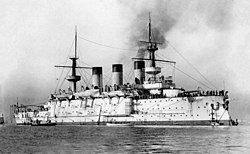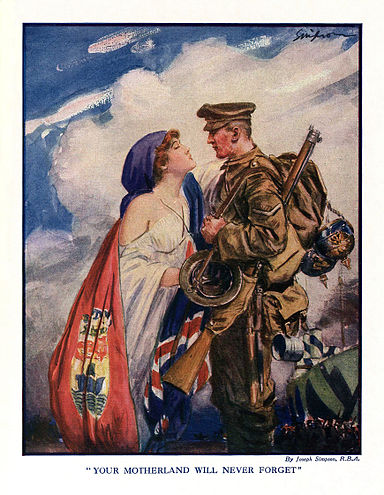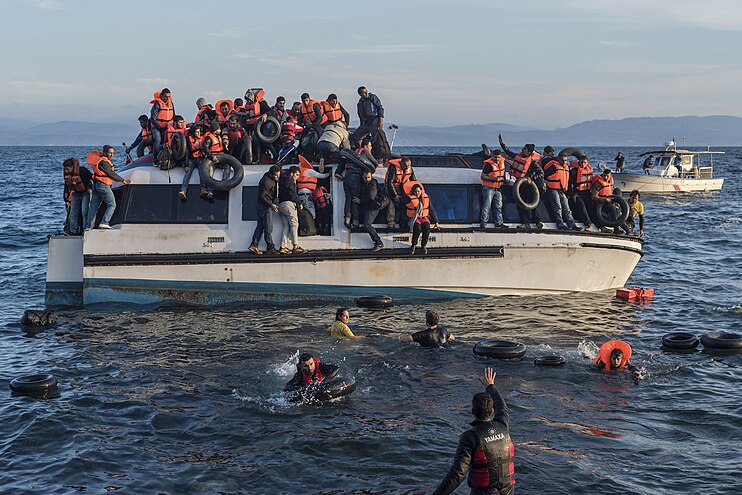|
New featured articles |


- Yugoslav monitor Sava ( Peacemaker67)
- One of only two surviving Austro-Hungarian river monitors from World War I, Sava served with the Austro-Hungarian, Yugoslav and Croatian navies throughout her long career, and fired the first shots of World War I on 28 July 1914. Launched in 1903 as Bodrog, after taking part in the Serbian and Romanian campaigns of the war, during the inter-war years the vessel was turned over to the newly created Kingdom of Serbs, Croats and Slovenes, but was quickly transferred again to the Royal Yugoslav Navy, who renamed her Sava. Following the Axis invasion of Yugoslavia in World War II, the ship was scuttled but was raised and subsequently served under the Croatian banner until 1944 when she was scuttled again. After the war, the monitor was once again re-raised and currently remains in existence as a heritage-listed gravel barge.
- Peresvet-class battleship ( Sturmvogel 66)
- The Peresvet-class comprised three pre-dreadnought battleships built for the Imperial Russian Navy around the end of the 19th century. They were designed to support armoured cruisers in commerce raids if war broke out with the British, but ultimately were not used in their intended role. Instead, they fought against the Japanese in 1904–05. All three ships were sunk during the war, although two were salvaged and placed into service by the Japanese after the war. One was sold back to the Russians in 1916 and sank again after hitting mines in the Mediterranean; the other participated in the Battle of Tsingtao in 1914, before being scrapped around 1923.
- Lexington-Concord Sesquicentennial half dollar ( Wehwalt)
- Also known as the "Lexington-Concord half dollar" or "Patriot half dollar", this commemorative coin was struck by the United States Mint in 1925 to honour the 150th anniversary of the Battles of Lexington and Concord. According to nominator Wehwalt, "...there's a nice little backstory about the towns of Lexington and Concord, such rivals that they apparently had to have different congressmen. I enjoyed researching this one, it's been a long time since high school history."
- Juan Manuel de Rosas ( Lecen)
- This article focusses on a major figure in South American history. As Lecen related in his nomination statement, Rosas was "probably the most well-known 19th century dictator in that region (after Francisco Solano López). For a brief moment he was almost able to turn Argentina into the main power in South America ... so powerful that the Empire of Brazil under Emperor Pedro II forged an alliance with his enemies to crush Rosas." The article was twice nominated unsuccessfully at FAC before achieving the gold star.
New featured pictures |
The two World Wars make a heavy dent into featured pictures this month, but the consequences of current wars also intrude.
-
You Forget - But She Remembers, a British Propoganda Poster of the Second World War.
created by "Whitear" and restored by Brandmeister -
The Thin Red Line from Canada in Khaki, a First World War Canadian magazine.
created by Harold H. Piffard and restored by Adam Cuerden -
Your Motherland Will Never Forget, also from Canada in Khaki.
created by Joseph Simpson and restored by Adam Cuerden -
Your King and Country Need You / A Wee "Scrap o' Paper" is Britain's Bond, a First World War Scottish recruitment poster.
created by Lawson Wood and restored by Adam Cuerden -
Syrian and Iraqi refugees arrive in Greece, 30 October 2015.
created by Ggia -
Women of Britain Say - "Go!", a First World War British recruitment poster.
created by E. J. Kealey and restored by Adam Cuerden
New A-Class articles |

- Chicago Pile-1 ( Hawkeye7)
- Continuing Hawkeye7's series on the Manhattan Project, this article covers the first-ever nuclear reactor. The reactor was assembled in November 1942 at the University of Chicago's main campus and moved to a facility in the outskirts of the city in 1943. It was used for research purposes rather than weapons production, and was operated until 1953 when it was dismantled and buried. Both the original site of the reactor and the location it was buried are marked with memorials.
- 1st Cavalry Division (Kingdom of Yugoslavia) ( Peacemaker67)
- The 1st Cavalry Division was a horse-mounted unit of the Yugoslav Army. Most of its combat units were detached to other formations following the Axis invasion of the country in April 1941, but the divisional headquarters was assigned an ad-hoc collection of other units and stragglers. It was unable to deploy into its intended defensive zone, however, and was disarmed by fifth column Ustase groups and German troops. Peacemaker developed the article from scratch to GA status in three weeks, and it passed its A-class review about three weeks later.
- 7th Army (Kingdom of Yugoslavia) ( Peacemaker67)
- Peacemaker's second appearance in the list is also his second A-class article covering a the Yugoslav Army. The 7th Army was responsible for guarding the country's north-western frontier with Italy and the Third Reich. It was still in the process of mobilising and deploying to its planned positions at the time of the Axis invasion, and was rapidly defeated.
|
|
New featured articles |


- Yugoslav monitor Sava ( Peacemaker67)
- One of only two surviving Austro-Hungarian river monitors from World War I, Sava served with the Austro-Hungarian, Yugoslav and Croatian navies throughout her long career, and fired the first shots of World War I on 28 July 1914. Launched in 1903 as Bodrog, after taking part in the Serbian and Romanian campaigns of the war, during the inter-war years the vessel was turned over to the newly created Kingdom of Serbs, Croats and Slovenes, but was quickly transferred again to the Royal Yugoslav Navy, who renamed her Sava. Following the Axis invasion of Yugoslavia in World War II, the ship was scuttled but was raised and subsequently served under the Croatian banner until 1944 when she was scuttled again. After the war, the monitor was once again re-raised and currently remains in existence as a heritage-listed gravel barge.
- Peresvet-class battleship ( Sturmvogel 66)
- The Peresvet-class comprised three pre-dreadnought battleships built for the Imperial Russian Navy around the end of the 19th century. They were designed to support armoured cruisers in commerce raids if war broke out with the British, but ultimately were not used in their intended role. Instead, they fought against the Japanese in 1904–05. All three ships were sunk during the war, although two were salvaged and placed into service by the Japanese after the war. One was sold back to the Russians in 1916 and sank again after hitting mines in the Mediterranean; the other participated in the Battle of Tsingtao in 1914, before being scrapped around 1923.
- Lexington-Concord Sesquicentennial half dollar ( Wehwalt)
- Also known as the "Lexington-Concord half dollar" or "Patriot half dollar", this commemorative coin was struck by the United States Mint in 1925 to honour the 150th anniversary of the Battles of Lexington and Concord. According to nominator Wehwalt, "...there's a nice little backstory about the towns of Lexington and Concord, such rivals that they apparently had to have different congressmen. I enjoyed researching this one, it's been a long time since high school history."
- Juan Manuel de Rosas ( Lecen)
- This article focusses on a major figure in South American history. As Lecen related in his nomination statement, Rosas was "probably the most well-known 19th century dictator in that region (after Francisco Solano López). For a brief moment he was almost able to turn Argentina into the main power in South America ... so powerful that the Empire of Brazil under Emperor Pedro II forged an alliance with his enemies to crush Rosas." The article was twice nominated unsuccessfully at FAC before achieving the gold star.
New featured pictures |
The two World Wars make a heavy dent into featured pictures this month, but the consequences of current wars also intrude.
-
You Forget - But She Remembers, a British Propoganda Poster of the Second World War.
created by "Whitear" and restored by Brandmeister -
The Thin Red Line from Canada in Khaki, a First World War Canadian magazine.
created by Harold H. Piffard and restored by Adam Cuerden -
Your Motherland Will Never Forget, also from Canada in Khaki.
created by Joseph Simpson and restored by Adam Cuerden -
Your King and Country Need You / A Wee "Scrap o' Paper" is Britain's Bond, a First World War Scottish recruitment poster.
created by Lawson Wood and restored by Adam Cuerden -
Syrian and Iraqi refugees arrive in Greece, 30 October 2015.
created by Ggia -
Women of Britain Say - "Go!", a First World War British recruitment poster.
created by E. J. Kealey and restored by Adam Cuerden
New A-Class articles |

- Chicago Pile-1 ( Hawkeye7)
- Continuing Hawkeye7's series on the Manhattan Project, this article covers the first-ever nuclear reactor. The reactor was assembled in November 1942 at the University of Chicago's main campus and moved to a facility in the outskirts of the city in 1943. It was used for research purposes rather than weapons production, and was operated until 1953 when it was dismantled and buried. Both the original site of the reactor and the location it was buried are marked with memorials.
- 1st Cavalry Division (Kingdom of Yugoslavia) ( Peacemaker67)
- The 1st Cavalry Division was a horse-mounted unit of the Yugoslav Army. Most of its combat units were detached to other formations following the Axis invasion of the country in April 1941, but the divisional headquarters was assigned an ad-hoc collection of other units and stragglers. It was unable to deploy into its intended defensive zone, however, and was disarmed by fifth column Ustase groups and German troops. Peacemaker developed the article from scratch to GA status in three weeks, and it passed its A-class review about three weeks later.
- 7th Army (Kingdom of Yugoslavia) ( Peacemaker67)
- Peacemaker's second appearance in the list is also his second A-class article covering a the Yugoslav Army. The 7th Army was responsible for guarding the country's north-western frontier with Italy and the Third Reich. It was still in the process of mobilising and deploying to its planned positions at the time of the Axis invasion, and was rapidly defeated.
|







